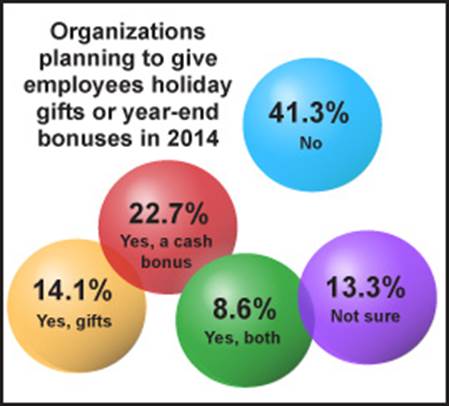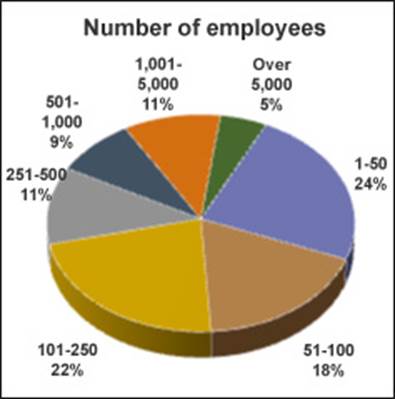In yesterday’s Advisor, we shared some results from our 2014 Holiday Practices Survey. Today, more findings from this timely study, including what organizations are doing regarding employee gifts, charitable donations, and decorations.
 |
A total of 2,666 individuals participated in this survey, conducted in October 2014.
Holiday Gifts
A cash bonus is planned for employees by 22.7%, gifts are planned by 14.1%, and 8.6% plan to offer both to their employees in 2015. The gifts include:
- Holiday meal, provided either at work or at a company-hosted party off-site, 31%
- “Take home” holiday meal, such as a ham or turkey, 10.5%
- Grocery store gift card, 15.4%
- Other gift card (e.g., gas card, prepaid debit, retail store), 21.4%
- Extra paid time off awarded, 1.3%
- Door prize or raffle giveaways, 7.1%
- Personal gifts, 13.2%

The size of planned bonuses are varied among respondents:
Holiday Cash Bonuses
| Bonus amount planned |
Response percent |
|
1% to 5% of base pay |
14.9% |
|
6% to 10% of base pay |
5.4% |
|
Lump sum of up to $250 |
23% |
|
Lump sum of $251 to $500 |
6.4% |
|
Lump sum of $501 to $1,000 |
5.3% |
Only gifts of nominal value may be accepted by employees from parties outside their organization (e.g., vendors, clients) for 41.9%. No employee gift policy is the norm for 24.3% and no gifts may be accepted is the rule for 16.4%. All gifts must be reported to the company for 14.9% and only if over a certain amount for 28.7%.
HR budget cuts? Let us help. HR.BLR.com is your one-stop solution for all your HR compliance and training needs. Take a no-cost, no-obligation trial and get a complimentary copy of our special report Critical HR Recordkeeping—From Hiring to Termination. It’s yours—no matter what you decide.
Deck the Halls
If their holiday decorations are within reason, 73.6% of survey participants (down from 82.6% last year) allow employees to display them. Another 18.8% (up from 12.1% last year) allow employees to display whatever they want. Display of nonreligious decorations only is allowed by 6%, and 1.6% (down from 3.2% last year) forbid employees from holiday decorating.
Along those same lines, 48.1% provide/display holiday-themed decorations in common areas at their facility, 18.3% do so only during Christmas, and 20.7% display only non-religious seasonal decor. No company-sponsored decorations are displayed by 12.9%.

Of the 72.5% (up from 70% last year) of survey participants that host year-end or holiday parties for their employees, 61.3% (57% last year) go off-site and 38.7% keep the festivities in-house. Alcoholic beverages are available for 53.9% (49% last year) and 36.6% (46% last year) allow spouses and/or significant others to attend the celebration.
Sharing
Though 10% have yet to decide about this year, charitable activities are sponsored by or participated in for 61.4% (65% last year). The types of activities are varied with sponsoring a food drive topping the list at 54.8%. Volunteer work or visits by employees during working hours ends the list at 22.7%. Here’s the complete list:
- Food drive, 54.8%
- Toy drive, 52.3%
- Angel tree and/or adopt a family, 45.9%
- Monetary donation from company, 31.5%
- Monetary donation collected from employees, 29.8%
- Clothing drive, 28.8%
- Volunteer work or visits by employees during working hours, 22.7%
Survey Participants
A total of 2,666 individuals participated in this survey, which was conducted in October 2014. Of those who identified themselves, 61.4% represent private, for-profit organizations, 20.3% represent private, nonprofit, 9.2% are public sector, and 9% work for government.
The majority (64.1%) of our survey respondents provide HR services to a workforce of 1-250 employees. Another 11.6% provide guidance to 251-500 employees at their organizations and 8.7% have a workforce of 501-1,000 employees. Companies with more than 1,000 employees account for 15.7% of survey participants.

Fewer than 8% of employers surveyed have a 50-100% unionized workforce. Also, 81.2% have a workforce with no union employees. A little over 26% of the respondents have a workforce of more than 50% exempt employees.
Over half (63.5%) of participants are in service industries; 23% are in agriculture, forestry, construction, manufacturing, or mining; 9.5% are in wholesale, retail, transportation, or warehousing; and 4.2% are in real estate or utilities.
Manager level is represented by 57.5% of survey participants and VP or higher accounts for 21.9%. Supervisors are represented by 5% and staff level account for 15.6% of survey participants who self-identified.
Thanks again to all who participated!
From setting the annual holiday calendar to dealing with the C-suite to routine discipline and documentation, HR never sleeps. You need a go-to resource, and our editors recommend the “everything-HR-in-one” website, HR.BLR.com®. As an example of what you will find, here are some policy recommendations concerning e-mail, excerpted from a sample policy on the website:
- Privacy. The director of information services can override any individual password and, therefore, has access to all e-mail messages in order to ensure compliance with company policy. This means that employees do not have an expectation of privacy in their company e-mail or any other information stored or accessed on company computers.
- E-mail review. All e-mail is subject to review by management. Your use of the e-mail system grants consent to the review of any of the messages to or from you in the system in printed form or in any other medium.
- Solicitation. In line with our general policy, e-mail must not be used to solicit for outside business ventures, personal parties, social meetings, charities, membership in any organization, political causes, religious causes, or other matters not connected to the company’s business.
Find out what the buzz is all about. Take a no-cost look at HR.BLR.com, solve your top problem, and get a complimentary gift.
We should point out that this is just one of hundreds of sample policies on the site. (You’ll also find analyses of all the HR-related laws and the current critical issues, plus downloadable job descriptions, and complete training materials for hundreds of HR topics.)
You can examine the entire HR.BLR.com® program free of any cost or commitment. It’s quite remarkable—30 years of accumulated HR knowledge, tools, and skills gathered in one place and accessible at the click of a mouse.
What’s more, we’ll supply a free, downloadable copy of our special report, Critical HR Recordkeeping—From Hiring to Termination, just for looking at HR.BLR.com. If you’d like to try it at absolutely no cost or obligation to continue (and get the special report, no matter what you decide), go here.
